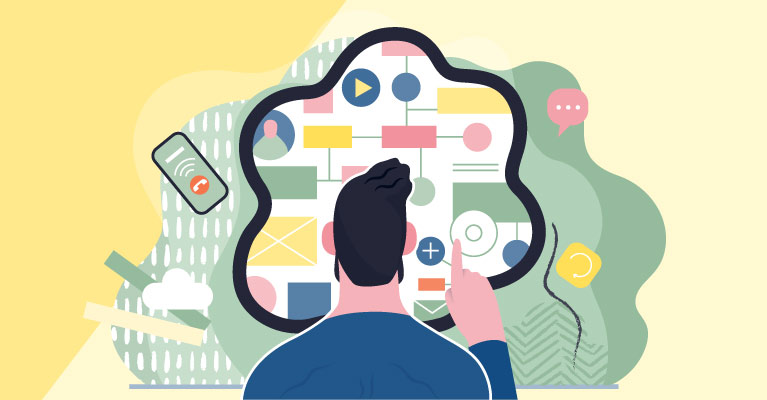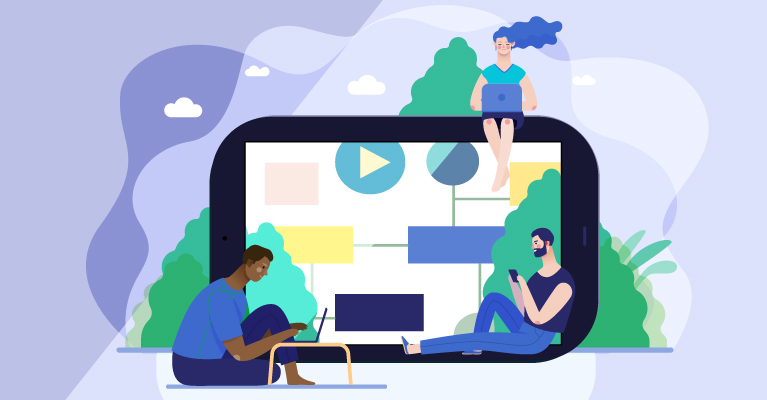Accessible Design for Classrooms

With 48 percent of students across the world using computers in the classroom, it’s imperative that school work is accessible to students with learning and physical disabilities. In fact, any student can benefit from accessibility when educators take a holistic approach to curriculum development and classroom design.
What’s the best way to make sure everyone in the classroom is able to understand and engage with the lesson? Professor William Myhill, adjunct faculty member at Syracuse University’s online Master of Science in Library and Information Science program, suggests using Universal Design for Learning, an educational framework that helps teachers create an inclusive learning environment for all students, whether or not they have a known disability.
Accessibility in the Classroom
Technology is revolutionizing the way children learn in and out of the classroom. Just within the past 10 years, desktop computers, smartphones and tablets have made it possible for students to access and create school assignments.
Technology in the Modern Classroom
The 2018 Global Education Census Report found the following:
Students use a variety of tools to complete their work:
90%
use a pen and paper
48%
use a desktop computer
42%
use a smartphone
20%
use a tablet
Students report use of technology for instruction:
33%
say smart boards are used
35%
say a blackboard is used
73%
say a whiteboard is used
Even though more teachers are assigning homework that’s completed or submitted online, not every student has equitable access to those assignments, especially if the assigned work includes multimedia features like videos, images or audio.
Some students may have developmental disabilities that require accommodations to use this technology, while other students may simply also benefit from those same accommodations for increased accessibility.
According to Myhill, there are two types of assistive technology in the classroom: Devices mandated by the Department of Disability Services like wheelchairs and screen readers, and accommodations that teachers go out of their way to make for the benefit of all students, like a transcript of a video being shown to the class.
Technological accommodations include keyboard shortcuts, voice-to-text capabilities, and adjustments for screen contrast and font size. Structural accommodations include automatic doors, wheelchair ramps, wide bathroom stalls, white noise machines, and adjustable chairs for students.
“I believe that we all have obligations to create our materials in accessible formats before we even deliver them or share them with our students,” said Myhill, who is also the University’s ADA coordinator.
Those obligations aren’t without challenges, though.
“When we have students with disabilities in the K-12 system they have an IEP, Individualized Education Plan, which means there needs to be some alternate format for taking an exam,” Myhill said. “Those requirements are placed on each individual teacher, who has to make those accommodations for that one student.”
The level of effort imposed upon teachers to make several unique accommodations for multiple students every time they create a lesson plan can be daunting. A teacher who wants to use YouTube videos as part of a lesson must make sure the video transcript isn’t just sufficient, but a meaningful substitute for the imagery. That means proofreading the transcript to make sure the dialogue is accurate, adding descriptions of visuals, and audio descriptions of music or ambiance: All of which can take just as many hours to create as the lesson plan itself.
Additionally, the implementation of a transcript or visual alternative could risk singling out students with disabilities. Myhill said a better solution is looking at accessibility as more than a disability issue.
Designing an Accessible Curriculum for Everyone
When making educational materials accessible, educators should think comprehensively about all the possible accommodations a group of people might need, and design one lesson plan that incorporates them.
“Give them some choices,” Myhill said, “so that they can use a modality that really resonates with them and allows them to show their best work.”
These larger changes might also help people who don’t depend on accommodations, but can still benefit from accessibility in a learning environment.
Universal Design Principles in the Classroom
Universal Design for Learning (UDL) is a framework for creating educational curricula that is inclusive to all types of learners, whether or not they have a known disability. The structure of UDL includes three main checkpoints for educators to consider when building a lesson plan.
ENGAGEMENT: Recognizing that students aren’t able to automatically activate their interest or motivation. Look for multiple ways to get students mentally and physically involved in the activity.
QUESTIONS TO ASK:
What do we need to do to get our students involved in the lesson?
How do we tap into what’s meaningful to students?
How do we show them that their personal and cultural experiences are valuable?
REPRESENTATION: The way information is presented can change how students understand or internalize the meaning. Look for ways to create representations that can be processed by students with learning disabilities like dyslexia, ADHD.
QUESTIONS TO ASK:
How do we provide information that we need our students to digest or use?
Can we provide this in multiple formats?
Does the main format favor one particular view or learning ability?
ACTION AND EXPRESSION: Some students may perform differently on standardized tests based on their ability and level of proficiency with that testing format. Consider offering multiple formats for a test or project, instead of grading with a standard rubric.
QUESTIONS TO ASK:
How do we ask our students to demonstrate that they’ve learned?
Does every student have an equal chance to succeed on this test?
What changes would help students express what they know?
For example, closed captions are helpful for people who are deaf or hard-of-hearing, but also help students who have sensory disorders or are on the autism spectrum. People who don’t rely on captions can still benefit from them, because captions visually reinforce auditory information, which helps students understand and retain information.
UDL helps teachers “build lessons that tap into student’s experiences and bring them into the class,” Myhill said. By providing different ways to interact with a lesson, they can demonstrate their abilities for a wide range of skills and proficiencies.
Getting Support for Assistive Technology
Assistive technology is any equipment or software that makes it easier to access, understand and navigate the physical or digital world.
Using assistive technology at home or during extracurricular activities can help students become more proficient and independent over time. Parents or educators who need help learning to use and implement this technology can use online tutorials or meet with a school librarian for a demonstration.
School districts can also ensure accessibility needs are being comprehensively considered by employing teachers, librarians, and administrators who have developmental or physical disabilities.
“All students need role models and need to see [that] their identity is valued in the school environment,” Myhill said.
In order to ensure students can access devices and software, some states have grants or programs that allow schools to provide accessible technology devices to students who need them.
Where to find or borrow assistive technology for students:
- The Center for Parent Information and Resources
- Common Sense Media — Learning Difficulties & Special Needs Guide
- Early Childhood Technical Assistance Center
- Easter Seals Equipment Lending Library
- Edutopia — The Ultimate Guide to Assistive Technology for Students With Special Needs
- National Center for Accessible Educational Materials — State-by-State Guide
- Pass it On Center
- Reading Rockets — Assistive Technology for Kids with Learning Disabilities
- Understood.org — Assistive Technology Basics




